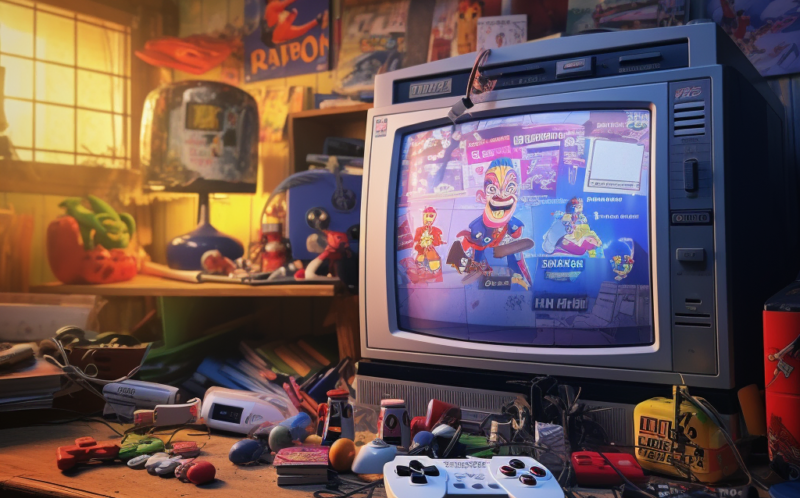The evolution of console gaming has been a remarkable process, reflecting technological advancements and shifts in popular culture.
Gaming consoles have transformed from simple devices into powerful entertainment hubs, impacting how we play and interact with games.
Not to mention that the video game industry has become so massive. If you want to follow the latest news from the industry, visit gamingwithswag.com.
Now, let us talk about the evolution of the consoles.
Foundations of Console Gamin

The journey of console gaming began with “Pong,” created by Atari in 1972. “Pong” was a simple yet groundbreaking game that simulated table tennis and became immensely popular, laying the foundation for the gaming industry.
It introduced the concept of interactive electronic entertainment to a wide audience, demonstrating the potential of video games beyond arcades.
Around the same time, the Magnavox Odyssey was introduced as the first home gaming console in 1972. Developed by Ralph H. Baer, the Odyssey was a rudimentary device compared to today’s standards but was revolutionary for its time.
It allowed players to connect the console to their television sets and play a variety of simple games using overlays and cartridges.
The creation of “Pong” and the Magnavox Odyssey marked the beginning of a new era. These early consoles proved that video games could be more than just a novelty; they could be a staple of home entertainment.
The Rise of Home Consoles

The late 1970s and early 1980s saw the rise of home consoles, with Atari leading the charge. The release of the Atari 2600 in 1977 was a game-changer.
It popularized the use of interchangeable cartridges, allowing players to switch games without needing a new console. Iconic games like “Space Invaders” and “Pac-Man” helped the Atari 2600 become a household name.
However, the industry faced a significant setback with the 1983 video game crash. The market was flooded with low-quality games, leading to a loss of consumer confidence.
Many companies went bankrupt, and the future of video games seemed uncertain. Despite this, the crash served as a turning point, paving the way for a more controlled and quality-focused industry.
The impact of Atari and the 1983 crash highlighted the potential and risks of the gaming industry. The lessons learned during this time influenced future console development and marketing strategies.
The 8-bit and 16-bit Eras
The mid-1980s to early 1990s marked the 8-bit and 16-bit eras, characterized by intense competition between Nintendo and Sega. Nintendo’s release of the Nintendo Entertainment System (NES) in 1985 revitalized the industry after the crash.
The NES introduced beloved franchises like “Super Mario Bros.” and “The Legend of Zelda,” which became cultural phenomena and set new standards for game design.
Sega entered the fray with the Sega Genesis (known as Mega Drive outside North America) in 1989. The Genesis offered more advanced graphics and faster processing power, positioning itself as a direct competitor to the NES.
This rivalry sparked the famous “console wars,” with both companies vying for dominance through innovative games and aggressive marketing campaigns.
Technological advancements during this era were significant. Nintendo introduced the concept of a “save game” battery, allowing players to save their progress, while Sega’s use of blast processing showcased the potential for faster and more dynamic gameplay.
Key titles from both companies, such as “Sonic the Hedgehog” and “Metroid,” pushed the boundaries of what video games could achieve.
The Shift to 3D Gaming

The mid-1990s heralded a major shift in the gaming landscape with the introduction of 3D graphics. Sony’s entry into the market with the PlayStation in 1994 revolutionized console gaming.
The PlayStation used CD-based games, allowing for larger storage capacity and more complex game designs. Iconic titles like “Crash Bandicoot” and “Final Fantasy VII” demonstrated the potential of 3D gaming and helped establish Sony as a major player in the industry.
Nintendo responded with the release of the Nintendo 64 in 1996. The console featured advanced 3D graphics capabilities and introduced revolutionary games such as “Super Mario 64” and “The Legend of Zelda: Ocarina of Time.” These games were not only visually impressive but also set new standards for gameplay mechanics and level design.
The shift to 3D gaming brought significant technological advancements. The use of polygons for character and environment models allowed for more realistic and immersive game worlds.
The introduction of analog sticks provided more precise control, enhancing the gameplay experience. This era marked a significant evolution in how games were developed and played, setting the stage for future innovations.
The Multimedia and Online Era
The early 2000s saw the advent of multimedia capabilities and online gaming with the release of the Xbox and PlayStation 2.
Microsoft’s entry into the console market with the Xbox in 2001 introduced Xbox Live, a revolutionary online gaming service that enabled players to connect and compete globally.
Games like “Halo: Combat Evolved” showcased the potential of online multiplayer and helped establish a thriving online gaming community.
Meanwhile, the PlayStation 2, released in 2000, became the best-selling console of all time. Its success was due in part to its role as a multimedia hub, capable of playing DVDs in addition to games.
Multifunctionality appealed to a broad audience, making the PS2 a central entertainment device in many households. Iconic titles like “Grand Theft Auto III” and “Metal Gear Solid 2” further solidified its place in gaming history.
Modern Consoles and Technological Advancements

The mid-2000s to early 2010s marked a period of significant technological advancements with the introduction of high-definition gaming and digital distribution.
The Xbox 360 and PlayStation 3, released in 2005 and 2006 respectively, brought high-definition graphics to the forefront. This era saw the rise of visually stunning games like “Halo 3” and “Uncharted,” which pushed the boundaries of what consoles could achieve.
Digital distribution became increasingly prevalent, with platforms like Xbox Live Marketplace and PlayStation Network allowing players to purchase and download games directly to their consoles. This shift changed the way games were consumed and distributed, providing greater convenience and accessibility for players.
Popular titles such as “The Last of Us” and “Halo 5: Guardians” demonstrated the power of these new systems, offering immersive storytelling and cutting-edge graphics.
The Bottom Line
From the humble beginnings of “Pong” to the advanced technology of the latest consoles, the journey of console gaming has been extraordinary. The industry continues to evolve, promising exciting developments and a bright future for gamers and technology enthusiasts alike.








